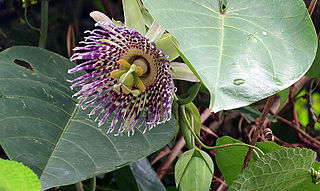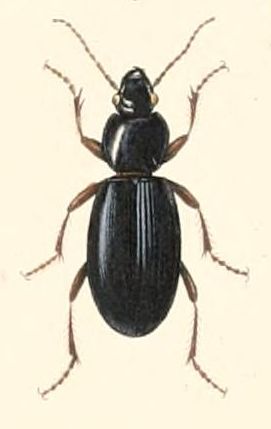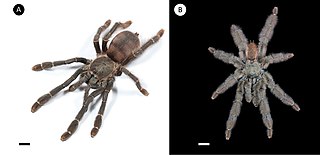
Ecuador, officially the Republic of Ecuador, is a country in northwestern South America, bordered by Colombia on the north, Peru on the east and south, and the Pacific Ocean on the west. Ecuador also includes the Galápagos Islands in the Pacific, about 1,000 kilometers (621 mi) west of the mainland. The country's capital is Quito and its largest city is Guayaquil.

The Cenepa War, also known as the Alto Cenepa War, was a brief and localized military conflict between Ecuador and Peru, fought over control of an area in Peruvian territory near the border between the two countries. The two nations had signed a border treaty following the Ecuadorian–Peruvian War of 1941, but Ecuador later disagreed with the treaty as it applied to the Cenepa and Paquisha areas, and in 1960 it declared the treaty null and void. Most of the fighting took place around the headwaters of the Cenepa River.

Chusquea is a genus of evergreen bamboos in the grass family. Most of them are native to mountain habitats in Latin America, from Mexico to southern Chile and Argentina.

Catasetum, abbreviated as Ctsm. in horticultural trade, is a genus of showy epiphytic Orchids, family Orchidaceae, subfamily Epidendroideae, tribe Cymbidieae, subtribe Catasetinae, with 166 species, many of which are highly prized in horticulture.

The Ecuadorian–Peruvian War, known locally as the War of '41, was a South American border war fought between 5–31 July 1941. It was the first of three military conflicts between Ecuador and Peru during the 20th century.

Passiflora ligularis, commonly known as the sweet granadilla or grenadia, is a plant species in the genus Passiflora. It is known as granadilla in Bolivia, Colombia, Nicaragua, Costa Rica, Ecuador, Mexico, The Azores, South Africa and Peru; granadilla común in Guatemala; granadilla de China or parcha dulce in Venezuela and granaditta in Jamaica.

The Ecuadorian–Peruvian territorial dispute was a territorial dispute between Ecuador and Peru, which, until 1928, also included Colombia. The dispute had its origins on each country's interpretation of what Real Cedulas Spain used to precisely define its colonial territories in the Americas. After independence, all of Spain's colonial territories signed and agreed to proclaim their limits in the basis of the principle of uti possidetis juris, which regarded the Spanish borders of 1810 as the borders of the new republics. However, conflicting claims and disagreements between the newly formed countries eventually escalated to the point of armed conflicts on several occasions.

Weinmannia is a genus of trees and shrubs in the family Cunoniaceae. It contains 90 species, which range from Mexico through Central and South America including the Caribbean, and to the Mascarene Islands in the western Indian Ocean. It is absent from mainland Africa and Australia, but some fossils have been attributed to Weinmannia in Australia.

Pamphobeteus is a genus of tarantulas that was first described by Reginald Innes Pocock in 1901. It includes some of the largest spiders in the world. They are found in South America, including the countries of Peru, Bolivia, Ecuador, Brazil, Colombia and Panama.
Atelopus pachydermus is a species of toad in the family Bufonidae. It is found in the Andes of northern Peru and southern Ecuador. Records from Colombia reflect the vagueness of the stated type locality, "Neu-Granada", encompassing territory part of several present-day countries. Other records outside the current range refer to other species. The most recent record of this very rare and possibly extinct species is from around 1995. However, there is a need to reassess the status of this species because of confusion with Atelopus podocarpus.

Minthostachys is a genus of the mint family Lamiaceae, comprising aromatic scandent shrubs. It occurs along the Andes from Northern Venezuela through Colombia, Ecuador, Peru and Bolivia to Central Argentina.

Blennidus is a genus in the beetle family Carabidae. There are more than 120 described species in Blennidus, found in South America.

Thrixopelma is a genus of South American tarantulas that was first described by Günter E. W. Schmidt in 1994. They are medium to large tarantulas, usually being 35mm to 60mm in body length.
Anyphaenoides is a genus of anyphaenid sac spiders first described by Lucien Berland in 1913. It is a senior synonym of "Quechuella"
Lasiodorides is a genus of South American tarantulas that was first described by Günter E. W. Schmidt & B. Bischoff in 1997.
Metagonia is a genus of cellar spiders that was first described by Eugène Louis Simon in 1893.

Amazonius is a genus of tarantulas first described by Cifuentes & Bertani in 2022. They are found in Venezuela, Colombia, Peru, Ecuador, Brazil and French Guiana. Two of the four species were originally from the Tapinauchenius genus, being A. burgessi, A. elenae.
Incaspis simonsii is a species of snake in the family Colubridae..
Incaspis tachymenoides, Schmidt's green racer, is a species of snake in the family Colubridae. The species is native to Chile and Peru.












